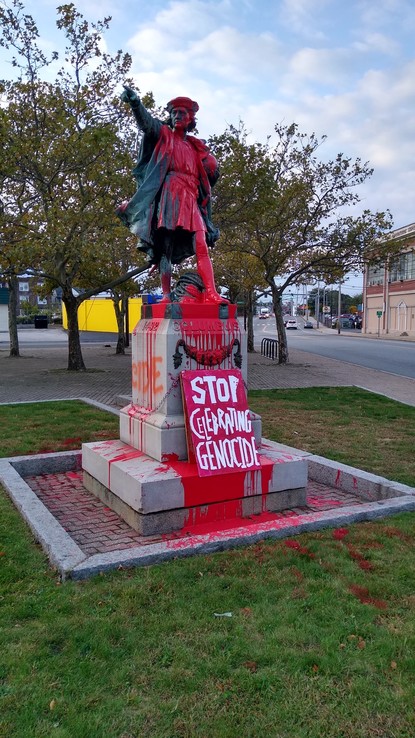With the ongoing protests surrounding equality for Black and colored people, around the world; the question of monuments (including statutes) has come up, rather forcefully. Should we continue celebrating Christopher Columbus, who treated the Native Americans cruelly? Should we celebrate his ‘discovery’ of the Americas as a great event or something that took away much more than freedoms from the Natives? These questions and related ones have become relevant. Whether it is King Leopold II of Belgium, Cecil Rhodes, or Christopher Columbus, several historical figures have come under the scanner for their role in perpetuating racism, genocide, and other crimes against humanity. It is time for the memory of the dead to be reimagined, for our present to be altered, to prevent a whitewashing of their sins.
How should contemporary policymakers deal with this question? I will try to deal with this tricky question, in this short post.
As a Newsweek article pointed out “Cities in the U.S. and elsewhere started celebrating Indigenous Peoples’ Day instead of Columbus Day during the late 1980s. Many have, and continue to, denounce Columbus as a colonizer who enslaved, killed and forced assimilation of indigenous populations.” The gap between how the state sees such historical figures and how civil society views them can create profound tensions. Alternate conceptions of the role of such historical figures and a reading of their actions in the context of current debates can throw up some uncomfortable truths that are hard to deal with, unless policy makers and those in power take a hard, critical look at the needs of the current generation.
The same Newsweek article pointed out that in the U.K., protestors “tore down a statue of slave trader Edward Colston, while others in Belgium vandalized statues of 19th century colonizer King Leopold II, responsible for the deaths of millions in what is now the Democratic Republic of Congo.” Such events of taking down statues are not only cathartic for people who are at the receiving end of the rhetoric of racism and discrimination, but also reflect a change in societal norms around what is celebrated and what is accepted.
Exploring the policy angle of memorializing: Philadelphia as an example
As Elizabeth J Burling writes in her Master’s thesis, several cities do not have a policy in place for which monuments were to be erected and on what basis.
This problem has persisted in the U.S. for a long time now. She adds “Indeed, Philadelphia’s relationship with memory has often been contentious – according to Gary Nash, author of First City: Philadelphia and the Forging of Historical Memory, no comprehensive history of the city was written prior to the 150th anniversary of the city’s founding,” (p.2). Her reminder that there is no distinction between works of historical significance and those used as an aesthetic expression is quite. This seems to be the case in Richmond, VA as well. Burling points out that this lack of a coordinated policy creates problems when new memorials are placed in traditional locations. She points to the distinction between a memorial and monument as one where “monuments are built to help us remember, memorials are about helping us never to forget.” Few cities such as Washington D.C. have a “24 step guide to memorialization in the Nation’s Capital,” an elaborate step by step process that helps the National Park Service decide how to go about the process of memorialization.
The history of Philadelphia’s regulations on public art is interesting. In 1959, the Aesthetic Ornamentation ordinance was initiated which set the level of public art for every construction project at one percent. Burling points to the work of De Monchaux and Schuster to articulate the five elements that should be included in any policy strategy for preserving heritage: a.Ownership and operation b.regulation c. incentives d. establishments, allocation, and enforcement of property rights and e. Information. Their argument is for governments to intervene to preserve the heritage and this task cannot be left to the private sector. Despite these five elements each city faces the question of what to memorialize. And this is precisely the question that comes to the fore when one considers history.
Whose history are we memorializing? The winners of the Civil War or that of the losers (Confederates). Given that there is still a sense of injustice and victimhood among Southerners, when it comes to the Civil War, these are raw wounds. Some groups/ nations are open to reevaluating the role of monuments and memorials in contemporary society. Others are not.
France for example, has decided that it will keep all statutes, even those that commemorate controversial figures in history. As Emmanuel Macron, the French President pointed out, this was his interpretation of acknowledging all of history. This is, at the end of the day, a policy choice, shaped by his political situation and what may be acceptable with the French people, at this point in time.
Aspects of the past have intruded our consciousness today and will continue to haunt us into the future. There is no way of getting around it, but rather only through it. How we answer the question of who we celebrate and why determines what kind of a nation we become. For nations are nothing but ‘imagined communities,’ as Benedict Anderson has quite elegantly shown. How each nation decides to remember its history is crucial to what sort of a nation it becomes.

